Abstract
Aim. The aim of this study was to test the agreement between orthopantomography (OPG) based 2D measurements and the KPG index, a new index based on 3D Cone Beam Computed Tomography (CBCT) images, in predicting orthodontic treatment duration and difficulty level of impacted maxillary canines. Materials and Methods. OPG and CBCT images of 105 impacted canines were independently scored by three orthodontists at t 0 and after 1 month (t 1), using the KPG index and the following 2D methods: distance from cusp tip and occlusal plane, cusp tip position in relation to the lateral incisor, and canine inclination. Pearson's coefficients were used to evaluate the degree of agreement and the χ 2 with Yates correction test was used to assess the independence between them. Results. Inter- and intrarater reliability were higher with KPG compared to 2D methods. Pearson's coefficients showed a statistically significant association between all the indexes, while the χ 2 with Yates correction test resulted in a statistically significant rejection of independency only for one 2D index. Conclusions. 2D indexes for predicting impacted maxillary canines treatment duration and difficulty sometimes are discordant; a 3D index like the KPG index could be useful in solving these conflicts.
1. Introduction
Maxillary canines are the second most frequently impacted teeth after the third molars. Considering the not negligible prevalence of impacted canines, ranging from 0.9% up to 5% [1–3] and the difficulties sometimes related to their orthodontic treatment, several authors have been trying to elaborate prognostic indexes in order to foresee, during the diagnostic process, some important factors such as treatment rough duration and difficulty level [4, 5]. These indexes were all based on two-dimensional (2D) radiographs, such as OPG, occlusal, periapical, and lateral cephalograms, which are all characterized by the reduction of the examined volume into flat images, with a variable distortion of real dimensions and with different possible patient positioning errors, further affecting image quality and trustworthiness [6–8].
Recently, also thanks to the rapidly increasing availability of CBCT scanners and their present status of gold standard in three-dimensional (3D) dental and maxillofacial radiology [9–11] for both pathological [12–14] and healthy patients [15, 16], a 3D index was proposed classifying impacted maxillary canines treatment difficulty into four categories: easy, moderate, difficult, and very difficult [17]. The use of this index was found to be reliable, considering its high inter- and intrarater reliability [18], and with a good level of agreement with the orthodontist's perception of treatment difficulty [19]. Furthermore the accuracy of CBCT measurements [20, 21] and the possibility to reorientate with a visualization software the acquired volumes when patient malpositioning eventually occurred during images acquisition [22, 23] contribute to strengthen the reliability of KPG index. Anyway, as far as we know, no comparison was realized until now between classical well known 2D index and this new 3D index outcomes.
Thus, the aim of this study was to compare inter- and intrarater reliability of 2D versus KPG indexes and to evaluate their level of agreement in impacted maxillary canines rating.
2. Materials and Methods
OPG and CBCT exams of 90 subjects, 15 with bilateral impactions and 75 with unilateral impactions, coming from three different radiological centers (A, B, C), were randomly extracted from our database obtaining a sample of 105 impacted canines. These records were independently scored with both 2D and 3D indexes, after a calibration meeting, by three orthodontists at t 0 and after 1 month (t 1). After that, a joint measuring session was organized (t 2) and these results were utilized for qualitative analysis: all discrepancies were resolved finding a common agreement.
30 patients (22 with unilateral and 8 with bilateral impacted maxillary canines) came from the radiological center A, where OPG images were obtained with an Orthophos XGplus Sirona digital machine set at 72 kV, 8 mA, and 15 seconds of exposure, while CBCT exams were realized with a NewTom 5G scanner set at 0.3 mm voxel and 15 × 15 cm Field of View (FOV) sizes, with a slice interval of 1 mm; 30 patients (27 with unilateral and 3 with bilateral impacted maxillary canines) came from the radiological center B, where OPG images were obtained with a Kodak 8000C digital machine set at 73 kVp, 12 mA, and 13.9 seconds of exposure, while CBCT exams were realized with a Kodak 9500 scanner set at 0.3 mm voxel and 15 × 9 cm FOV sizes, with a slice interval of 1 mm; and 30 patients (26 with unilateral and 4 with bilateral impacted maxillary canines) came from the radiological center C, where OPG images were obtained with an Instrumentarium OP100 digital machine set at 73 kV, 12 mA, and 17.6 seconds of exposure, while CBCT exams were realized with a Planmeca Promax Mid scanner set at 0.2 mm voxel and 16 × 9 cm FOV sizes, with a slice interval of 1 mm.
CBCT images, after Digital Imaging and Communications in Medicine (DICOM) files export, were visualized with the following software: NNT Viewer for radiological center A; Kodak Dental Imaging 3D-module software for center B; and Planmeca Romexis software for center C. OPG images were extracted from the original software, saved as JPEG files, and viewed using Windows Photo Viewer (Microsoft Corporation, Redmond, WA, USA). All the radiological images were visualized on a 16 : 9 27′′ Light Emitting Diodes (LED) backlighting monitor display (iMac, Apple, Cupertino, CA, USA) with a 2560 × 1440 pixel screen resolution.
2.1. KPG Index
KPG index was calculated adding together the scores, from 0 to 5, assigned to cusp tip and root tip on x, y, and z planes (Figures 1, 2, 3, and 4): in the original version scores in the range 0–9 fell into the category of easy, 10–14 were moderate, 15–19 were difficult, and 20–30 were extremely difficult; in the modified version the category of easy was reduced to 0–6 scores, extending the category of moderate from 7 to 14. In order to compare the KPG index with 2D indexes, these four categories were reduced to two, creating an easy-moderate category in the range 0–14 and a difficult-very difficult category in the range 15–30.
Figure 1.
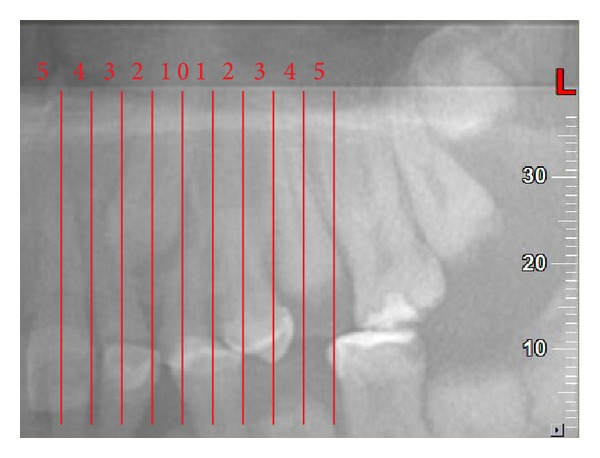
Mesiodistal position (x) for both cusp and root tips; panorex view. In this example C x = 2 and R x = 1.
Figure 2.

Vertical position (y) for cusp tip; panorex view. In this example C y = 3.
Figure 3.
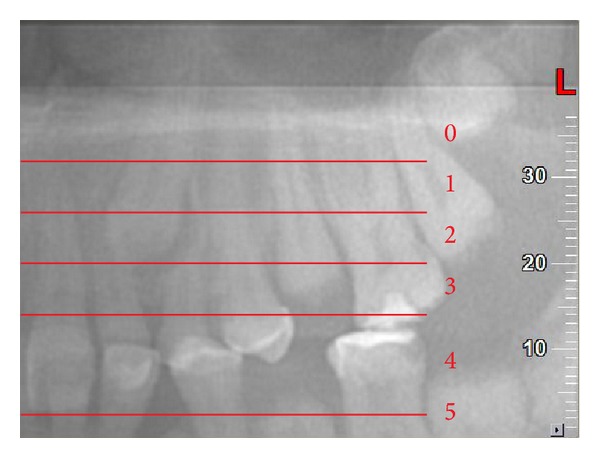
Vertical position (y) for root tip; panorex view. In this example R y = 0.
Figure 4.
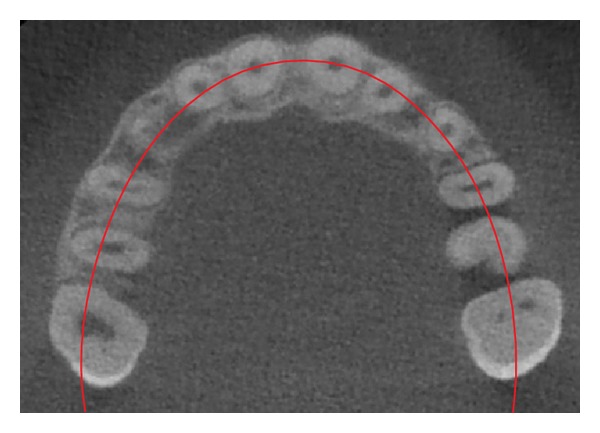
Occlusal reference arch (z); axial view. In this example C z = 2 and R z = 3, therefore the KPG index value is 11—moderate difficulty (2 + 1 + 3 + 0 + 2 + 3 = 11), in this study considered as shorter and easier.
2.2. 2D Methods
After a literature review, we identified three different 2D measurements on OPG that were commonly used to predict treatment duration or difficulty degree when planning an impacted maxillary canine orthodontic treatment: the vertical distance from the cusp tip perpendicularly to the occlusal plane, traced from the first upper molar to the central upper incisor (Figure 5); the mesiodistal position of the canine tip with respect to the adjacent teeth (Figure 6); the canine inclination, α-angle, to a vertical line traced between the two central incisors (Figure 7).
Figure 5.
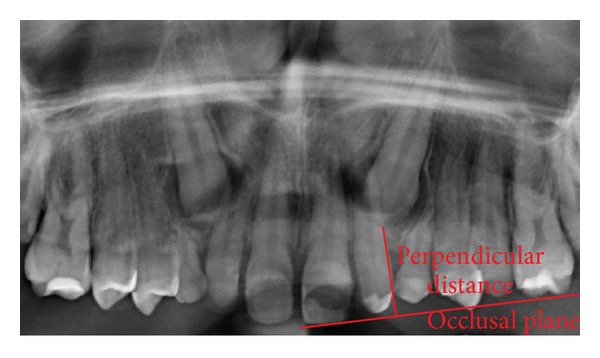
Vertical distance from the cusp tip perpendicularly to the occlusal plane, traced from the first upper molar to the central upper incisor. In this example, 14.8 mm, corresponding to a longer treatment according to Stewart.
Figure 6.
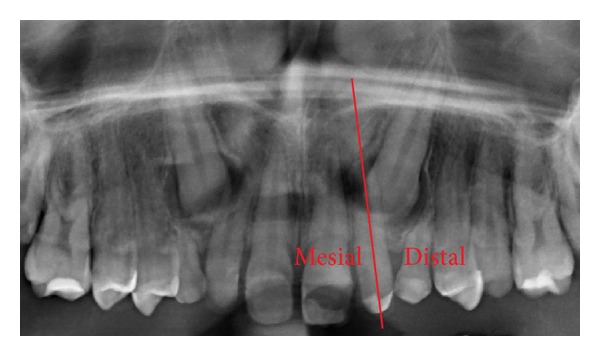
Mesiodistal position of the canine tip with respect to the adjacent teeth. In this example the canine is distal to the lateral, corresponding to an easier treatment according to Ericson and Kurol.
Figure 7.
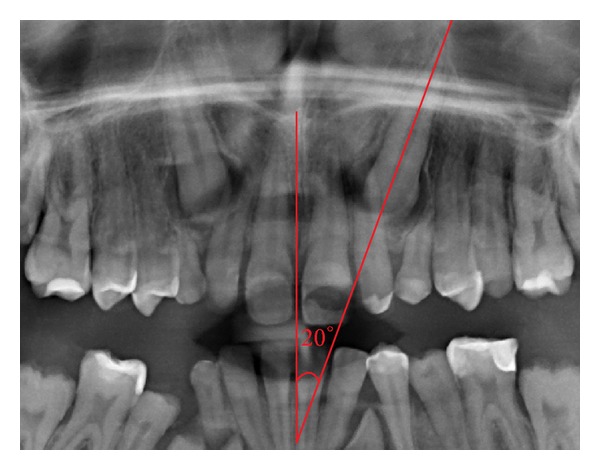
Canine inclination, α-angle, to a vertical line traced between the two central incisors. In this example α-angle is 20°.
According to Stewart et al. [4], vertical distances from the cusp tip perpendicularly to the occlusal plane measuring less than 14 mm were associated with shorter treatment duration, and that one measuring 14 mm or more was associated with longer treatment duration. Therefore, comparing this measurement with KPG index, we considered two categories: shorter treatment under 14 mm and longer treatment for 14 mm or more.
According to Ericson and Kurol [5], canines with cusp tip position in sectors 1-2, distal to the lateral incisor vertical midline, were considered easier to treat, compared to canines with a more mesial position, corresponding to sectors 3–5. Therefore, comparing this measurement with KPG index, we considered two categories: easier treatment when cusp tip was distal to the lateral incisor midline and difficult treatment when cusp tip was more mesially positioned.
According to Crescini et al. [24], every 5° of opening of the α-angle required approximately 1 more week of active orthodontic traction. It was not possible to identify a cut-off value between shorter and longer treatments; then this measurement was not compared with the KPG index.
2.3. Sample Description
The present study was based on filed CBCT exams (of both treated and untreated cases) randomly extracted from our database; that is, the exams were not expressly performed for our study aims but were prescribed based on clinical evaluations, pondered case by case, because of ectopic position of the canine. The CBCT examination was considered supplemental to conventional radiographic examination. Informed consent to undergo the additional radiographic examination and to use the material for future studies was obtained from all patients and parents/tutors.
2.4. Statistical Analysis
Inter- and intrarater reliability for both 2D and 3D methods were calculated, utilizing Cohen's kappa and Kendall's W coefficients, respectively. Both coefficients range from 0 to 1, with higher values indicating a stronger relationship: values ≤ 0.01 indicate poor agreement and values between 0.01 and 0.20 slight agreement, between 0.21 and 0.40 fair agreement, between 0.41 and 0.60 moderate agreement, between 0.61 and 0.80 substantial agreement, between 0.81 and 0.99 almost perfect agreement, and 1 perfect agreement.
The qualitative mean results (short or long, easy or difficult), obtained at t 2 from these methods, were plotted using contingency tables, and Pearson's coefficients were calculated in order to evaluate the degree of agreement. Conversely, the χ 2 with Yates correction (or continuity correction) test was used to assess the independence between them.
The Pearson coefficient ranges from −1.0 to +1.0: −1.0 is a strong inverse relationship, 0 indicates no relationship, and +1.0 is a strong direct relationship. Values between 0.3 and 0.5 indicate a medium correlation, and between 0.5 and 1.0 a high correlation. We set statistical significance at 0.05 and we did not rely upon Pearson coefficient values when P > 0.05.
The χ 2 test compares the observed frequency with the expected frequency in each category in a contingency table. Even if our sample dimension was rather large, nevertheless, we decided to use a continuity correction such as the Yates correction, considering that we were approximating a continuous χ 2 distribution by discrete observations and that the 2 × 2 tables that we utilized only have one degree of freedom. Statistical significance was set at 0.05.
In our study, we set a null kappa value of 0.40; the level at which the kappa is statistically significantly different than the null value was set at 0.70 (a 0.30 difference should be the smallest difference tested); 80% power was selected and the expected proportion of positive ratings, based on our previous studies, was determined at 70%. The sample size for the 80% power required to detect Kappa values significantly different from 0.40 was 85 impacted canines [25]. We selected a total of 105 canines to anticipate any possible measuring complication.
All the measurements were statistically analyzed using SPSS Statistics version 19 (SPSS Inc., Chicago, IL) software.
3. Results
3.1. Inter- and Intrarater Agreement
Cohen's Kappa values, obtained comparing t 0 and t 1, were the following: between 0.803 and 0.956 for KPG index, indicating an almost perfect intrarater agreement; between 0.786 and 0.922 for Ericson and Kurol's analysis, indicating substantial or in some cases almost perfect intrarater agreement; between 0.691 and 0.879 for Stewart's measurement, indicating substantial or in some cases almost perfect intrarater agreement.
Kendall's W values were the following: 0.967 at t 0 and 0.989 at t 1 for the KPG index, thus demonstrating an almost perfect interrater statistical agreement; 0.801 at t 0 and 0.892 at t 1 for Ericson and Kurol's analysis, thus demonstrating an almost perfect interrater statistical agreement; 0.775 at t 0 and 0.844 at t 1 for Stewart's measurement, thus demonstrating a substantial or in some cases almost perfect interrater statistical agreement.
3.2. 2D and 3D Indexes Agreement
Table 1 shows the comparative results regarding the prediction of treatment duration with KPG index and Stewart's measurement of canine's cusp tip vertical distance from occlusal plane. Considering Stewart's measurement as the reference standard, the sensitivity of KPG index was 0.846, while the specificity and negative predictive values were both 0.556. There was a statistically significant (P < 0.05) moderate (r = 0.402) association between the results obtained with both analyses, but conversely it was not possible to reject their independence at a strong statistically significant level (P = 0.053).
Table 1.
Contingency table comparing KPG index vs. Stewart's measurement.
(a).
| KPG | Stewart | Total | |
|---|---|---|---|
| Shorter | Longer | ||
| Shorter | 66 | 12 | 78 |
| Longer | 12 | 15 | 27 |
|
| |||
| Total | 78 | 27 | 105 |
(b) Chi-square tests
| Value | P value | |
|---|---|---|
| Pearson correlation (r) | 0.402 | 0.017∗ |
| Yates χ 2 | 3.741 | 0.053 |
| Positive likelihood ratio | 1.904 | |
| Negative likelihood ratio | 0.277 | |
| Sensitivity | 0.846 | |
| Specificity | 0.556 | |
| Positive predictive value | 0.846 | |
| Negative predictive value | 0.556 |
∗Statistically significant association.
Table 2 shows the comparative results regarding the prediction of treatment difficulty degree with KPG index and Ericson and Kurol's analysis of canine's cusp tip position relative to the lateral incisor bisecting axis. Considering Ericson and Kurol's analysis as the reference standard, the sensitivity of KPG index was 0.941, while the specificity and negative predictive values were 0.444 and 0.889, respectively. There was a statistically significant (P < 0.01) moderate (r = 0.441) association between the results obtained with both analyses and a rejection of independency at a statistically significant level (P < 0.05).
Table 2.
Contingency table comparing KPG index versus Ericson and Kurol analysis.
(a).
| KPG | Ericson and Kurol | Total | |
|---|---|---|---|
| Easy | Difficult | ||
| Easy | 48 | 30 | 78 |
| Difficult | 3 | 24 | 27 |
|
| |||
| Total | 51 | 54 | 105 |
(b) Chi-square tests
| Value | P value | |
|---|---|---|
| Pearson correlation (r) | 0.441 | 0.008∗ |
| Yates χ 2 | 4.937 | 0.026† |
| Positive likelihood ratio | 1.694 | |
| Negative likelihood ratio | 0.132 | |
| Sensitivity | 0.941 | |
| Specificity | 0.444 | |
| Positive predictive value | 0.615 | |
| Negative predictive value | 0.889 |
∗Statistically significant association.
†Statistically significant rejection of independency.
Table 3 shows the comparative results between Stewart's measurement and Ericson and Kurol's analysis. Considering Ericson and Kurol's analysis as the reference standard, the sensitivity of Stewart's measurement was 0.824, while the specificity and negative predictive values were 0.333 and 0.667, respectively. There was no statistically significant (P = 0.303) association between the results obtained with both analyses, and it was not possible to reject their independence at a statistically significant level (P = 0.500).
Table 3.
Contingency table comparing Stewart's measurement versus Ericson and Kurol's analysis.
(a).
| Stewart | Ericson and Kurol | Total | |
|---|---|---|---|
| Easy | Difficult | ||
| Shorter | 42 | 36 | 78 |
| Longer | 9 | 18 | 27 |
|
| |||
| Total | 51 | 54 | 105 |
(b) Chi-square tests
| Value | P value | |
|---|---|---|
| Pearson correlation (r) | 0.179 | 0.303 |
| χ 2 | 0.455 | 0.500 |
| Positive likelihood ratio | 1.235 | |
| Negative likelihood ratio | 0.529 | |
| Sensitivity | 0.824 | |
| Specificity | 0.333 | |
| Positive predictive value | 0.538 | |
| Negative predictive value | 0.667 |
4. Discussion
Orthodontic treatment of impacted canines is an interesting and absorbing challenge for every orthodontist, both from the diagnostic and the therapeutic point of view [26]. Several techniques were suggested to prevent, intercept or actively treat impacted maxillary canines, depending on patient age, canine position, presence of a malocclusion, and conditions of surrounding teeth [27–30].
Sometimes the final therapeutic decision (canine extraction or orthodontic traction; type and timing of orthodontic traction) could be a quandary for both the patient and the orthodontist, and in these cases treatment duration and difficulty degree are factors of crucial importance to considerate: for this reason, several authors tried to elaborate different methods to estimate them, utilizing radiographic images such as OPG, occlusal, periapical, and lateral cephalograms [31, 32].
OPG evaluation is the most common clinical approach used by orthodontists as first screening radiological exam, which is why we decided to focus our interest on OPG derived indexes. We tested the agreement of KPG index with these well-known 2D indexes as a first step in its validation process.
Unfortunately, several factors could affect 2D images quality and accuracy, due to patient positioning errors or even to distortion effects inherent to the radiological technique used. In order to limit these confounding factors, aiming to evaluate the efficacy of a prognostic index, in several studies only one radiologist was allowed to perform all radiological exams, always with the same equipment. We decided to test the effectiveness of these indexes; therefore, we included radiological images coming from different radiological centers, utilizing different equipment: this allowed us to simulate everyday conditions occurring in an orthodontic practice, where radiological images origin could be rather heterogeneous and could also explain the difference that we found in our study regarding intra- and interrater reliability of 2D indexes, even if also some other studies pointed out this possible lack of accuracy when using 2D radiological images. On the other hand, high quality protocols adopted by the radiological centers involved in the present study, thus producing radiological images with a very low incidence of technical errors, helped us to limit this confounding effect when assessing these indexes performance.
Nevertheless, as reported by several authors, the reliability of OPG in the anterior maxilla is limited: an overestimation of impacted canines angle and distance compared to the midline is generally present; furthermore, in patients with small interincisors angles or with an important intermaxillary discrepancy, apical or coronal parts of anterior teeth could appear out of focus or even invisible [33]. Finally, images alteration along the horizontal plane tends to be nonlinear [34] and also vertical measurements are not completely reliable [35].
This could explain why some measures were found to be related to treatment duration or difficulty degree only in some studies, while they were considered noninfluential by some others: if canine position has an important role in determining treatment peculiarity, it must be determined without imaging errors that act as confounding factors [36, 37]. For this reason, a 3D radiographic technique such as CBCT, thanks to the accuracy of its derived measurements, is of critical importance in exactly determining impacted canines position, and an index based on these images could be more reliable compared to those based on 2D dataset.
Stewart found that the greater the distance that the canine must move to correctly erupt, the longer the treatment will take; he was aware that the third dimension of the anterior maxilla cannot be seen on an OPT, and then he hypothesized that the more vertically displaced the impacted canine is, the longer could be this distance. Finally he concluded that 3D radiological techniques use could allow us to better understand how the position of an impacted canines relates to treatment duration.
In our study, we found a weaker correlation between Stewart's measurement and KPG index, compared to Ericson and Kurol's analysis. This could be due to the fact that the vertical position of canine's cusp tip is only one of the six factors considered by the KPG index: consequently its contribution to the overall index could be masked by the remaining five. Furthermore, the threshold of 14 mm between shorter and longer treatments was found only after data analysis, and it was not hypothesized during the study design, based on clinical or theoretical evaluations: not being hypothesis driven, the results of this study could be biased by accidental characteristics of the analyzed sample.
Otherwise, Ericson and Kurol's analysis was based on a prospective clinical trial; after that they found that spontaneous eruption of impacted canines with the crown tip mesial to the lateral midline was significantly less likely to happen after corresponding primary canine extraction, compared to more distal ones. Moreover, due to anatomical factors, canine angulation tends to increase while it migrates more mesially: this fact has an impact on root apex x and y scores when rating KPG index; then it could explain why the concordance between these two indexes is higher.
We also fund that Ericson and Kurol's analysis results and Stewart's measurements were not significantly associated: this could seem obvious, considering that the first one was conceived to evaluate treatment difficulty, whereas the second one aimed to predict treatment duration. Nevertheless, it must be considered that usually more complex impacted canines need longer treatments in order to be driven in their correct position.
Finally, CBCT images are of fundamental importance in recognizing the presence of adjacent teeth root resorption, impacted canines root anomalies, and possible overlap between canine's crown and incisor's roots, even if there is not yet an agreement regarding their usefulness in planning canine's surgical exposure and direction of active orthodontic traction [38–41].
Undoubtedly, the retrospective design of most of the studies that tried to correlate canine position with treatment duration and difficulty degree contributed to weaken 2D indexes reliability. Several factors, which in a retrospective study are difficult to control, could influence treatment development: age, malocclusion complexity degree, number of failed appointments and orthodontic appliances breakages, oral hygiene maintenance, patient compliance, and treatment protocol.
An appropriately designed prospective clinical trial, taking into account and monitoring all of these confounding factors, will be able to find a stronger evidence regarding factors influencing impacted maxillary canines treatment duration and difficulty level, allowing us also to clinically validate the KPG index or, if it is not the case, to correct it or to elaborate a new reliable 3D index, accounting for canine's real spatial position influence on them.
5. Conclusions
Our results demonstrate the following:
Ericson and Kurol's analysis and Stewart's 2D indexes for predicting impacted maxillary canines treatment duration and difficulty sometimes are discordant;
intra- and interrater agreement are higher for KPG index, when compared to these 2D indexes;
the KPG index, considering the canine position in all the three dimensions, allows us to exactly evaluate the distance of the crown from the ideal position.
Conflict of Interests
The authors declare that there is no conflict of interests regarding the publication of this paper.
Authors' Contribution
All authors read and approved the final paper. Domenico Dalessandri coordinated the study development, participated in its design, performed the experimental part, and wrote the paper. Marco Migliorati and Luca Visconti participated in drafting the paper and performed the experimental part. Luca Contardo was involved in selecting and performing statistical analysis. Chung How Kau was involved in interpreting data and revised the paper critically for important intellectual content. Conchita Martin conceived the study, participated in its design, and was involved in performing the statistical analysis and making substantial contributions to interpretation of data.
References
- 1.Luglié PF, Fideli L, Cellai A, Cossi R, Lissia M. Etiological, epidemiological and clinical assessment of the problem of impacted canines. Minerva stomatologica. 1986;35(6):583–587. [PubMed] [Google Scholar]
- 2.Baccetti T. A controlled study of associated dental anomalies. The Angle Orthodontist. 1998;68(3):267–274. doi: 10.1043/0003-3219(1998)068<0267:ACSOAD>2.3.CO;2. [DOI] [PubMed] [Google Scholar]
- 3.Ericson S, Kurol J. Radiographic examination of ectopically erupting maxillary canines. American Journal of Orthodontics and Dentofacial Orthopedics. 1987;91(6):483–492. doi: 10.1016/0889-5406(87)90005-9. [DOI] [PubMed] [Google Scholar]
- 4.Stewart JA, Heo G, Glover KE, Williamson PC, Lam EWM, Major PW. Factors that relate to treatment duration for patients with palatally impacted maxillary canines. American Journal of Orthodontics and Dentofacial Orthopedics. 2001;119(3):216–225. doi: 10.1067/mod.2001.110989. [DOI] [PubMed] [Google Scholar]
- 5.Ericson S, Kurol J. Early treatment of palatally erupting maxillary canines by extraction of the primary canines. European Journal of Orthodontics. 1988;10(4):283–295. doi: 10.1093/ejo/10.4.283. [DOI] [PubMed] [Google Scholar]
- 6.Mckee IW, Glover KE, Williamson PC, Lam EW, Heo G, Major PW. he effect of vertical and horizontal head positioning in panoramic radiography on mesiodistal tooth angulations. The Angle Orthodontist. 2001;71(6):442–451. doi: 10.1043/0003-3219(2001)071<0442:TEOVAH>2.0.CO;2. [DOI] [PubMed] [Google Scholar]
- 7.Nagpal A, Pai KM, Setty S, Sharma G. Localization of impacted maxillary canines using panoramic radiography. Journal of oral Science. 2009;51(1):37–45. doi: 10.2334/josnusd.51.37. [DOI] [PubMed] [Google Scholar]
- 8.Sameshima GT, Asgarifar KO. Assessment of root resorption and root shape: periapical vs panoramic films. The Angle Orthodontist. 2001;71(3):185–189. doi: 10.1043/0003-3219(2001)071<0185:AORRAR>2.0.CO;2. [DOI] [PubMed] [Google Scholar]
- 9.Brown J, Jacobs R, Levring Jäghagen E, et al. Basic training requirements for the use of dental CBCT by dentists: a position paper prepared by the European Academy of DentoMaxilloFacial Radiology. Dentomaxillofacial Radiology. 2014;43(1) doi: 10.1259/dmfr.20130291.20130291 [DOI] [PMC free article] [PubMed] [Google Scholar]
- 10.Kau CH, Božič M, English J, Lee R, Bussa H, Ellis RK. Cone-beam computed tomography of the maxillofacial region—an update. International Journal of Medical Robotics and Computer Assisted Surgery. 2009;5(4):366–380. doi: 10.1002/rcs.279. [DOI] [PubMed] [Google Scholar]
- 11.Frongia G, Piancino MG, Bracco P. Cone-beam computed tomography: Accuracy of three-dimensional cephalometry analysis and influence of patient scanning position. Journal of Craniofacial Surgery. 2012;23(4):1038–1043. doi: 10.1097/SCS.0b013e318252d5e1. [DOI] [PubMed] [Google Scholar]
- 12.Laffranchi L, Dalessandri D, Tonni I, Paganelli C. Use of CBCT in the orthodontic diagnosis of a patient with pycnodysostosis. Minerva Stomatologica. 2010;59(11-12):653–661. [PubMed] [Google Scholar]
- 13.Dalessandri D, Laffranchi L, Tonni I, et al. Advantages of cone beam computed tomography (CBCT) in the orthodontic treatment planning of cleidocranial dysplasia patients: a case report. Head and Face Medicine. 2011;7(1, article 6) doi: 10.1186/1746-160X-7-6. [DOI] [PMC free article] [PubMed] [Google Scholar]
- 14.Farronato G, Garagiola U, Carletti V, Cressoni P, Mercatali L, Farronato D. Change in condylar and mandibular morphology in juvenile idiopathic arthritis: cone beam volumetric imaging. Minerva stomatologica. 2010;59(10):519–534. [PubMed] [Google Scholar]
- 15.Mah JK, Huang JC, Choo H. Practical applications of cone-beam computed tomography in orthodontics. Journal of the American Dental Association. 2010;141(10) supplement 3:7S–13S. doi: 10.14219/jada.archive.2010.0361. [DOI] [PubMed] [Google Scholar]
- 16.American Academy of Oral and Maxillofacial Radiology. Clinical recommendations regarding use of cone beam computed tomography in orthodontics . [corrected]. Position statement by the American Academy of Oral and Maxillofacial Radiology. Oral Surgery, Oral Medicine, Oral Pathology and Oral Radiology. 2013;116(2):238–257. doi: 10.1016/j.oooo.2013.06.002. [DOI] [PubMed] [Google Scholar]
- 17.Kau CH, Pan P, Gallerano RL, English JD. A novel 3D classification system for canine impactions—the KPG index. The International Journal of Medical Robotics and Computer Assisted Surgery. 2009;5(3):291–296. doi: 10.1002/rcs.260. [DOI] [PubMed] [Google Scholar]
- 18.Dalessandri D, Migliorati M, Rubiano R, et al. Reliability of a novel CBCT-based 3D classification system for maxillary canine impactions in orthodontics: the KPG index. The Scientific World Journal. 2013;2013:7 pages. doi: 10.1155/2013/921234.921234 [DOI] [PMC free article] [PubMed] [Google Scholar]
- 19.Kau CH, Lee JJ, Souccar NM. The validation of a novel index assessing canine impactions. European Journal of Dentistry. 2013;7(4):399–404. doi: 10.4103/1305-7456.120648. [DOI] [PMC free article] [PubMed] [Google Scholar]
- 20.Dalessandri D, Bracco P, Paganelli C, Hernandez Soler V, Martin C. Ex vivo measurement reliability using two different cbct scanners for orthodontic purposes. International Journal of Medical Robotics and Computer Assisted Surgery. 2012;8(2):230–242. doi: 10.1002/rcs.458. [DOI] [PubMed] [Google Scholar]
- 21.Frongia G, Piancino MG, Bracco AA, Crincoli V, Debernardi CL, Bracco P. Assessment of the reliability and repeatability of landmarks using 3-D cephalometric software. Cranio: Journal of Craniomandibular Practice. 2012;30(4):255–263. doi: 10.1179/crn.2012.039. [DOI] [PubMed] [Google Scholar]
- 22.Lee JK, Jung PK, Moon CH. Three-dimensional cone beam computed tomographic image soft tissues as reference for facial asymmetry diagnosis. The Angle Orthodontist. 2014;84(1):38–47. doi: 10.2319/112112-890.1. [DOI] [PMC free article] [PubMed] [Google Scholar]
- 23.Kim S, Park S, Kim Y, Cho B, Hwang D. The reliability of cone-beam computed tomography (CBCT)—generated frontal cephalograms. Journal of Cranio-Maxillofacial Surgery. 2012;40(8):e331–e336. doi: 10.1016/j.jcms.2012.01.016. [DOI] [PubMed] [Google Scholar]
- 24.Crescini A, Nieri M, Buti J, Baccetti T, Prato GPP. Orthodontic and periodontal outcomes of treated impacted maxillary canines: an appraisal of prognostic factors. Angle Orthodontist. 2007;77(4):571–577. doi: 10.2319/080406-318.1. [DOI] [PubMed] [Google Scholar]
- 25.Sim J, Wright CC. The kappa statistic in reliability studies: Use, interpretation, and sample size requirements. Physical Therapy. 2005;85(3):257–268. [PubMed] [Google Scholar]
- 26.Laffranchi L, Dalessandri D, Fontana P, Visconti L, Sapelli P. Cone beam computed tomography role in diagnosis and treatment of impacted canine patient's: a case report. Minerva Stomatologica. 2010;59(6):363–376. [PubMed] [Google Scholar]
- 27.Becker A, Chaushu S. Success rate and duration of orthodontic treatment for adult patients with palatally impacted maxillary canines. American Journal of Orthodontics and Dentofacial Orthopedics. 2003;124(5):509–514. doi: 10.1016/s0889-5406(03)00578-x. [DOI] [PubMed] [Google Scholar]
- 28.Leonardi M, Armi P, Franchi L, Baccetti T. Two interceptive approaches to palatally displaced canines: a prospective longitudinal study. The Angle Orthodontist. 2004;74(5):581–586. doi: 10.1043/0003-3219(2004)074<0581:TIATPD>2.0.CO;2. [DOI] [PubMed] [Google Scholar]
- 29.Kokich VG. Surgical and orthodontic management of impacted maxillary canines. The American Journal of Orthodontics and Dentofacial Orthopedics. 2004;126(3):278–283. doi: 10.1016/j.ajodo.2004.06.009. [DOI] [PubMed] [Google Scholar]
- 30.Baccetti T, Leonardi M, Armi P. A randomized clinical study of two interceptive approaches to palatally displaced canines. European Journal of Orthodontics. 2008;30(4):381–385. doi: 10.1093/ejo/cjn023. [DOI] [PubMed] [Google Scholar]
- 31.San Martín DE, English JD, Kau CH, et al. The KPG index—a novel 3D classification system for maxillary canine impactions. Texas Dental Journal. 2012;129(3):265–274. [PMC free article] [PubMed] [Google Scholar]
- 32.Zuccati G, Ghobadlu J, Nieri M, Clauser C. Factors associated with the duration of forced eruption of impacted maxillary canines: a retrospective study. American Journal of Orthodontics and Dentofacial Orthopedics. 2006;130(3):349–356. doi: 10.1016/j.ajodo.2004.12.028. [DOI] [PubMed] [Google Scholar]
- 33.Fleming PS, Scott P, Heidari N, Dibiase AT. Influence of radiographie position of ectopic canines on the duration of orthodontic treatment. Angle Orthodontist. 2009;79(3):442–446. doi: 10.2319/042708-238.1. [DOI] [PubMed] [Google Scholar]
- 34.Tronje G, Welander U, McDavid WD, Morris CR. Image distortion in rotational panoramic radiography. III. Inclined objects. Acta Radiologica - Series Diagnosis. 1981;22(5):585–592. doi: 10.1177/028418518102200513. [DOI] [PubMed] [Google Scholar]
- 35.Tronje G, Eliasson S, Julin P, Welander U. Image distortion in rotational panoramic radiography. II. Vertical distances. Acta Radiologica: Diagnosis. 1981;22(4):449–455. doi: 10.1177/028418518102200409. [DOI] [PubMed] [Google Scholar]
- 36.Alqerban A, Jacobs R, Fieuws S, Willems G. Comparison of two cone beam computed tomographic systems versus panoramic imaging for localization of impacted maxillary canines and detection of root resorption. European Journal of Orthodontics. 2011;33(1):93–102. doi: 10.1093/ejo/cjq034. [DOI] [PubMed] [Google Scholar]
- 37.Botticelli S, Verna C, Cattaneo PM, Heidmann J, Melsen B. Two-versus three-dimensional imaging in subjects with unerupted maxillary canines. European Journal of Orthodontics. 2011;33(4):344–349. doi: 10.1093/ejo/cjq102. [DOI] [PubMed] [Google Scholar]
- 38.Alqerban A, Jacobs R, Souza PC, Willems G. In-vitro comparison of 2 cone-beam computed tomography systems and panoramic imaging for detecting simulated canine impaction-induced external root resorption in maxillary lateral incisors. American Journal of Orthodontics and Dentofacial Orthopedics. 2009;136(6):764.e1–764.e11. doi: 10.1016/j.ajodo.2009.03.036. [DOI] [PubMed] [Google Scholar]
- 39.Alqerban A, Jacobs R, Fieuws S, Nackaerts O, Willems G. Comparison of 6 cone-beam computed tomography systems for image quality and detection of simulated canine impaction-induced external root resorption in maxillary lateral incisors. American Journal of Orthodontics and Dentofacial Orthopedics. 2011;140(3):e129–e139. doi: 10.1016/j.ajodo.2011.03.021. [DOI] [PubMed] [Google Scholar]
- 40.Alqerban A, Hedesiu M, Baciut M, et al. Pre-surgical treatment planning of maxillary canine impactions using panoramic vs cone beam CT imaging. Dento Maxillo Facial Radiology. 2013;42(9) doi: 10.1259/dmfr.20130157. [DOI] [PMC free article] [PubMed] [Google Scholar]
- 41.Mah JK, Alexandroni S. Cone-beam computed tomography in the management of impacted canines. Seminars in Orthodontics. 2010;16(3):199–204. [Google Scholar]


